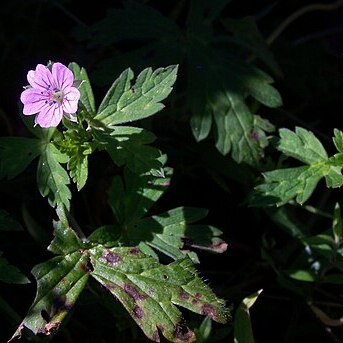Perennials. Rootstock ± vertical, 2-5.8 mm in diam., not tuberculate, without thickened roots. Stem 27-72 cm tall, trailing or ascending, sometimes rooting at nodes, with 0.2-1.4 mm patent or retrorse appressed nonglandular trichomes. Stipules lanceolate to subulate, distinct. Leaves opposite; petiole with 0.2-1.5 mm patent to retrorse nonglandular trichomes; leaf blade 2.3-4.1 cm, palmately cleft, ratio of main sinus/middle segment length = 0.78-0.89, pilose with appressed nonglandular trichomes; segments 5, broadly rhombic, 3.7-6.5 mm wide at base, 6-12-lobed in distal half, ratio of second sinus/middle segment length = 0.15-0.27. Cymules solitary, (1 or)2-flowered; peduncle 1.2-8.3 cm. Pedicel 1.1-2.5 cm, with 0.2-1 mm patent to retrorse nonglandular trichomes; bracteoles linear-lanceolate. Sepals 4.1-5.8 mm, mucro 0.4-1 mm, ratio of mucro/sepal length = 0.09-0.21, outside 0.4-1.1 mm with ± patent nonglandular trichomes, inside glabrous. Petals white, pale pink, or rarely deep pink, 5.1-5.9(-6.3) mm, erect to patent, both surfaces and margin with a few trichomes, apex rounded or slightly notched. Staminal filaments whitish, lanceolate with an abruptly narrowed apex, abaxially pilose and proximal half ciliate, trichomes 0.1-0.4 mm; anthers violet, 0.3-0.9 mm. Nectaries 5, hemispheric, glabrous. Stigma reddish. Fruit 1.4-1.8 cm, erect when immature; mericarps smooth with 1 transversal vein at apex, with a basal callus, with 0.3-1.3 mm ± patent nonglandular trichomes; rostrum 0.9-1.2 cm, with a 1-2 mm narrowed apex; stigmatic remains 0.8-1.4 mm. Seeds 1.9-2.3 mm. Fl. Apr-Sep, fr. May-Oct. 2n = 26, 28.
More
Leaves 5-partite, 11-14(-18) by 20-25(-29) mm, the middle segment pin nately lobed, free for 0.85-0.9th of its length, 1.25-2.25 mm wide at the base of its free part, diamond-shaped in outline, lobes with a rounded apiculate apex, lateral and marginal nerves distinct, upper surface sparsely to moderately strigose between the nerves, lower surface strigose, especially on the nerves. Inflorescences 1-or 2-flowered, peduncle in fruit 55-150 mm long, pedicels then 20-30 mm. Petals c. 5.2 mm long, pale lilac with 3 purple nerves and dark lilac venation, subequal to the 5-5.5 mm long sepals. Sepals in fruit c. 6 mm long.
A herb. It grows about 50 cm high. The branches have long soft hairs. The leaves have long stalks. They are opposite. They have 3-5 lobes. The flowers are pink with purple veins. The fruit is a capsule. It splits open from the base to the tip.

